Today’s dish, Squid with Green Vinegar Dressing (Midorizu) is a visually impressive dish. It is perfect as a starter or a side dish in a formal Japanese-style meal. Or serve it as nibbles to go with drinks. The vinegar is based on Tosazu which is one of the basic Japanese dressings.
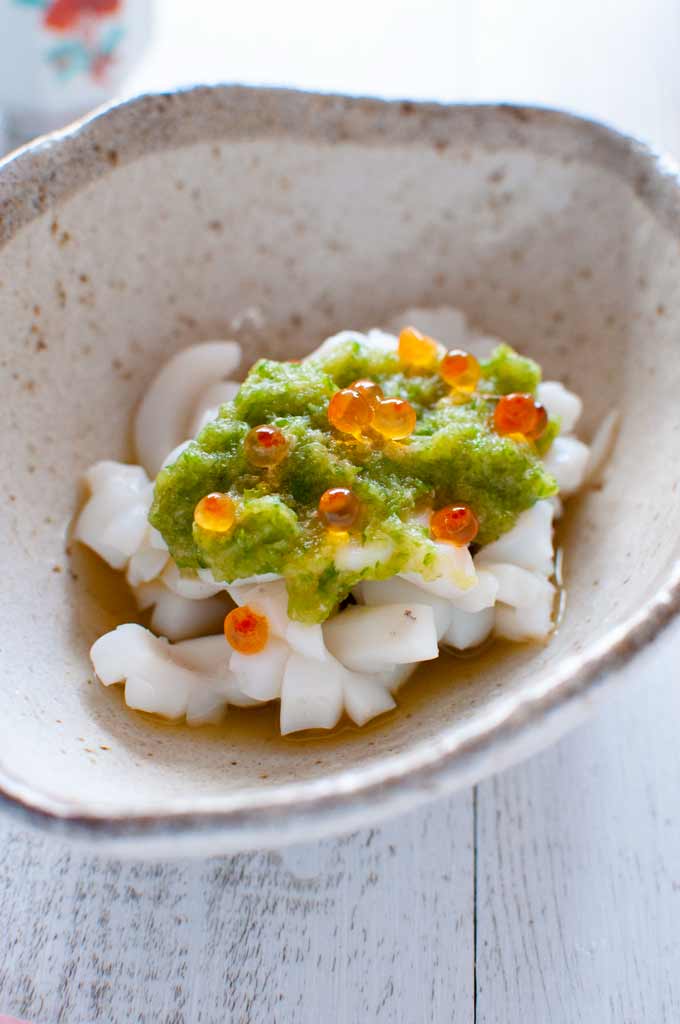
The Green Vinegar Dressing is versatile and goes well with seafood, particularly squid, octopus, scallops. It is also used with blanched white meat fish and steamed/blanched chicken breast or tenderloin.
About Midorizu
The Green Vinegar Dressing is called ‘Midorizu’ (緑酢), which is made with grated cucumber. The colour is amazing, isn’t it?
The Japanese word for ‘green’ is ‘midori’ (緑), which is where the name of this dressing came from. The word ‘zu’ is the same thing as ‘su’ (酢) and it means vinegar or vinegar dressing. The sound changes for easier pronunciation.

Midorizu is simply a mixture of grated cucumber and Tosazu and you can find the recipe for Tosazu in my post Japanese Dressings.
A similar dressing to Midorizu is the dressing made with grated daikon instead of cucumber. It is called ‘mizorezu’ (みぞれ酢). In my post Smoked Salmon with Grated Daikon (Mizore-ae), I talked about how grated daikon is called ‘mizore’ . Since the grated daikon is mixed with vinegar the dressing is called mizorezu.
What is in my Squid with Green Vinegar Dressing (Midorizu)
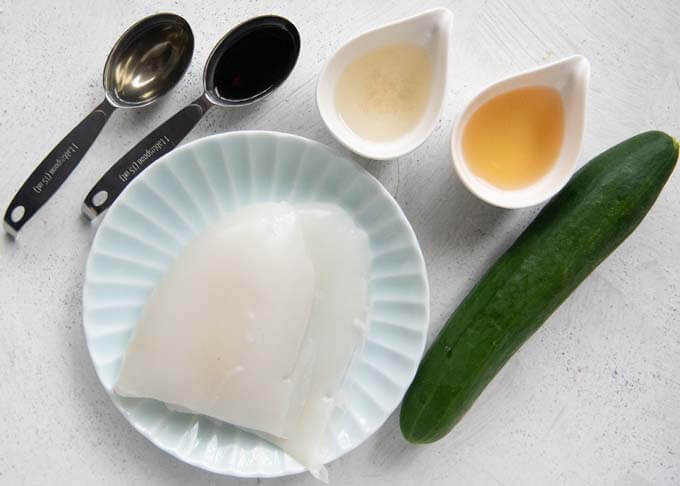
The dressing, Midorizu, is made of the following:
- Grated cucumber
- 2 parts rice vinegar
- 1 part soy sauce (or light soy sauce)
- 1 part mirin
- 2 parts dashi stock
Excluding the cucumber, the ingredients above are the same as those used in making the Tosazu in my post Japanese Dressings. I reduced the amount of dashi stock here though, because you get the extra liquid from the grated cucumber.
The balanced quantity of the cucumber and the vinegar dressing is 100g / 3.5oz cucumber with 6 tablespoons of dressing.
Other ingredients are:
- Squid, cuttlefish or calamari, cleaned and skin removed
- Salmon roe (ikura) for decoration
I used a couple of small cuttlefish today. The fish shop kindly cleaned the cuttle fish for me. I did not use tentacles this time but sometimes I do.

Ikura, if you have it, is a great decoration for today’s dish. It not only adds a bright orange to the dish, which is already colourful, but also gives a different texture to the dish
Instead of ikura you can use small tomatoes like this if you would like to brighten up the dish.
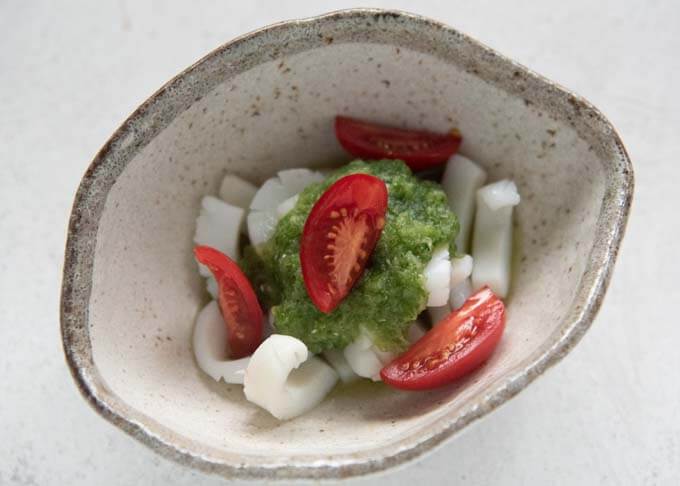
How to make Squid with Green Vinegar Dressing (Midorizu)
You will be surprised to know how pretty you can make the dish in such a simple way. And when you eat it, you will be surprised again as it is delicious and so refreshing.
- Open the tube of the squid and score the surface with a crisscross pattern.
- Cut the squid into 1cm wide and 5cm long strips.
- Blanch the squid strips and drain.
- Mix the Midorizu ingredients.
- Plate the squid pieces, pour the Midorizu on the squid and scatter the salmon roe.

If you are cleaning a squid yourself, please visit my post Squid with cucumber and Wakame Nuta, which describes how to clean squid with step-by-step photos.
Scoring one side of the squid serves a few purposes:
- Making the squid pieces decorative
- Squid pieces are not chewy to eat
- Cooks faster
Blanching the squid takes only a minute or less. I let it cool down naturally. The grated cucumber needs to be drained to remove excess water, otherwise the dressing becomes too thin. I gently squeeze the grated cucumber in a sieve.
I like blanched squid as it is tender. The vivid colour of green over the white squid is appetising. This is a simple squid recipe but salmon roes scattered on top makes you feel like eating a lavish food!
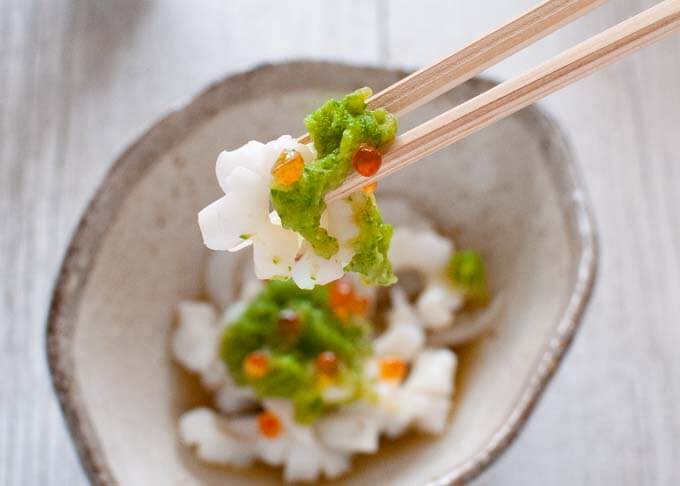
Yumiko![]()

Today’s dish, Squid with Green Vinegar Dressing (Midorizu) is a visually impressive dish. It is perfect for a starter or a side dish in a formal Japanese-style meal. The vinegar is based on Tosazu, which is one of the basic Japanese dressings.
Prep Time assumes the squid is already cleaned.
Don't forget to see the section 'MEAL IDEAS' below the recipe card! It gives you a list of dishes that I have already posted and this recipe that can make up a complete meal. I hope it is of help to you.
- 200g / 7oz squid ( cleaned and skin removed, note 1)
- 100g / 3.5oz cucumber
- 2 tbsp rice wine vinegar
- 1 tbsp light soy sauce or normal Japanese soy sauce
- 1 tbsp mirin
- 2 tbsp dashi stock
- Salmon roe (note 2)
-
Open the tube of the squid and score one side of the surface with a criss-cross pattern. The width of the criss-cross should be about 5mm / 3⁄16" and the depth is about halfway.
-
Cut the squid into 1cm / ⅜” wide and 5cm / 2" long strips.
-
Bring water in a pot to a boil and blanch the squid strips for 45-60 seconds. Drain and cool.
-
Grate cucumber and drain excess liquid using a sieve. Gently squeeze or press down the grated cucumber and remove more liquid. The cucumber should still be wet but not too watery.
-
Put the grated cucumber into a bowl and add the rest of the Midorizu ingredients. Mix gently.
-
Put the squid pieces in serving bowls, shaping them into a mound. Pour the Midorizu over the squid and scatter the salmon roe if using.
1. You can also use cuttlefish or calamari. I used two small cuttlefish. If your squid is not cleaned, please visit my recipe, Squid with cucumber and Wakame Nuta, which explains how to clean squid with step-by-step photos.
Even if the type of squid is different, the fundamental techniques to clean it are pretty much the same.
2. Salmon roe is called ikura in Japanese. You might find that it is even sold as 'ikura' at fish markets and some supermarkets.
Ikura is one of the fish eggs served on sushi. Raw ikura is usually sold in a small jar but they are not cheap. You might also find smoked ikura in a jar, which is slightly cheaper than the raw ikura.
Instead of ikura, you can scatter small tomato pieces (see the photo in the post).
3. Nutrition per serving.
serving: 99g calories: 65kcal fat: 0.9g (1%) saturated fat: 0.2g (1%) trans fat: 0.0g polyunsaturated fat: 0.3g monounsaturated fat: 0.1g cholesterol: 121mg (40%) sodium: 307mg (13%) potassium: 191mg (5%) carbohydrates: 4.4g (1%) dietary fibre: 0.2g (1%) sugar: 201g protein: 8.7g vitamin a: 1% vitamin c: 5.4% calcium: 1.7% iron: 2.7%
Meal Ideas
A typical Japanese meal consists of a main dish, a couple of side dishes, a soup and rice. I try to come up with a combination of dishes with a variety of flavours, colours, textures and make-ahead dishes.
When one of the side dishes is a squid dish, I feel like having grilled fish to go with it. Grilled Whiting Fillets is perfect, particularly if you are having a glass of wine or sake since they can also be served as nibbles.
Vegetable Agebitashi adds a different flavour to the meal.
- Main: Grilled Whiting Fillets (Dried Fish) – make ahead dried fish and grill when serving
- Side dish 1: Squid with Green Vinegar Dressing (Midorizu) – today’s recipe
- Side dish 2: Fried Vegetables in Broth (Vegetables Agebitashi) – make ahead
- Soup: Miso Soup of your choice from Miso Soup Ingredient Combinations or your favourite ingredients
- Rice: Cooked Rice
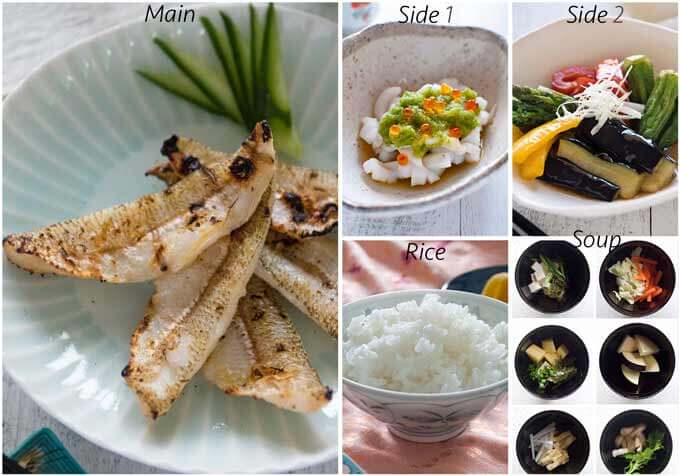
Leave a Reply